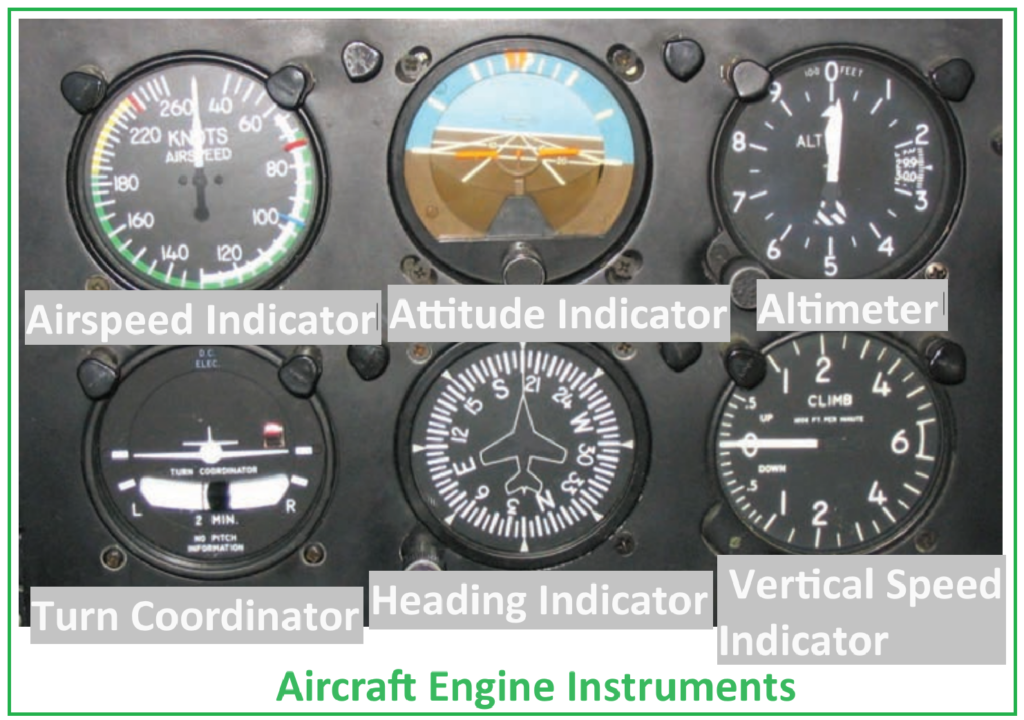Aircraft engine instruments are essential for monitoring the performance and health of the aircraft’s propulsion system. These instruments provide critical information to pilots and maintenance crews to ensure the engine operates safely and efficiently throughout the flight.

Here are some of the key engine instruments commonly found in aircraft:
- Tachometer: The tachometer measures the rotational speed of the engine, usually displayed in revolutions per minute (RPM). It provides pilots with real-time feedback on engine speed, allowing them to control throttle settings and monitor engine performance.
- Carburetor Air Temperature Indicator (for piston aircraft only): Indicates the temperature of air entering the carburetor. Monitoring carburetor air temperature helps pilots optimize fuel-air mixture for efficient combustion and engine performance.
- Oil Temperature Indicator (inlet and outlet): Measures the temperature of engine oil at the inlet and outlet. Monitoring oil temperature is crucial for ensuring proper lubrication and preventing engine overheating or oil degradation.
- Turbine Inlet Temperature and Exhaust Gas Temperature Indicator (for jet aircraft only): Indicates the temperature at the turbine inlet and the temperature of the exhaust gases. Monitoring these temperatures is essential for detecting engine overheating and ensuring safe operation of jet engines.
- Fuel Pressure and Oil Pressure Indicator: Displays the pressure of the fuel and lubricating oil systems. Maintaining proper pressure levels is critical for engine performance and reliability.
- Fuel Tank Level Indicator: Provides information about the level of fuel in the aircraft’s tanks. Monitoring fuel levels helps pilots manage fuel consumption and plan refueling stops during flight.
- Thrust Indicator (for jets) and Motor Torque Indicator (for propellers): Measures the engine’s thrust output in jets and the torque generated by propellers. These indicators help pilots optimize engine performance and monitor power output during different flight phases.
- Manifold Pressure Gauge: The manifold pressure gauge indicates the pressure of the air-fuel mixture entering the engine’s cylinders. It helps pilots optimize engine power output by adjusting throttle settings based on altitude and atmospheric conditions.
- Cylinder Head Temperature (CHT) Gauge: The CHT gauge measures the temperature of the engine’s cylinder heads. Monitoring CHT is crucial for preventing engine overheating and ensuring proper combustion within the cylinders.
- Exhaust Gas Temperature (EGT) Gauge: The EGT gauge measures the temperature of the exhaust gases leaving the engine’s cylinders. It provides valuable insight into engine performance and fuel-air mixture efficiency, helping pilots optimize fuel consumption and prevent engine damage.
- Oil Pressure Gauge: The oil pressure gauge indicates the pressure of the engine’s lubricating oil system. Maintaining proper oil pressure is essential for preventing engine wear and ensuring adequate lubrication of moving parts.
- Oil Temperature Gauge: The oil temperature gauge measures the temperature of the engine’s lubricating oil. Monitoring oil temperature helps prevent oil degradation and ensures optimal engine performance, especially during cold starts or extended operations.
- Fuel Flow Meter: The fuel flow meter measures the rate of fuel consumption by the engine. It allows pilots to monitor fuel usage in real-time and make informed decisions regarding fuel management and flight planning.
These engine instruments work together to provide pilots with comprehensive information about engine performance, allowing them to operate the aircraft safely and efficiently. By monitoring these critical parameters, pilots can detect potential issues early, optimize engine operation, and ensure a smooth and reliable flight.